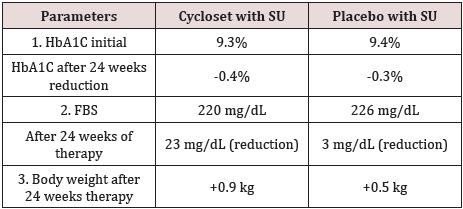Lupine Publishers| Bromocriptine - A Novel Therapy in Type-2 Diabetes
Abstract
Bromocriptine is used in treatment of diabetes mellitus. It acts by increasing dopaminergic activity in hypothalamus and lowers HbA1c by 0.6 to 0.9%. It is not to be used in type 1 diabetes and DKA.
Keywords:Bromocriptine; Hypothalamus; Contra indicators; Infarction; Combination therapy; Quick release bromocriptine
Introduction
Bromocriptine mesylate is a new modality of treatment for type-2 diabetes. The drug increases dopaminergic activity in the hypothalamus. It lowers HbA1c by 0.6 to 0.9% compared to placebo when added to other oral anti-diabetic agents. It regulates metabolic rhythm. The drug increases insulin sensitivity [1]. There is 24% increase in insulin mediated glucose disposal. Reduces fasting and post prandial hyper insulinemia by 30-70%. Body fat stores and insulin action are controlled by temporal interactions of circadian neuro-endocrine oscillations. Bromocriptine modulates neurotransmeter action in the brain and has been shown to improve glucose tolerance and insulin resistance in obesity and diabetes. Bromocriptine improves glycemic control and glucose tolerance in obese type-2 DM. Both fasting and post prandial blood glucose are reduced. This is due to enhanced maximally stimulated insulin mediated glucose disposal [2]. No change in body weight or BMI occurred with this therapy. Mechanism of Action is unclear. It resets the circadian rhythm at hypothalamic level [3,4]. Preclinical data suggest that decreased hypothalamic dopaminergic tone may be involved in the pathogenesis of insulin resistance. The normal circadian cycle that results in a leaner body in the summer and heavier body in winter is disrupted in humans because of abundant caloric intake year-round resulting in the absence of a lean phase. Stimulation of the hypothalamus promotes the release of several hormones that respond to the traditional shift in caloric intake and storage. Quick-release bromocriptine (D2 against), given once in the morning, stimulates the hypothalamus to release cortisol, growth hormone, and prolactin, allowing a reset of the circadian clock permanently stuck in a winter rhythm. This means there occurs resetting of abnormally elevated hypothalamic drive for increased plasma glucose, triglyceride and free fatty acid levels in fasting and postprandial states in insulin-resistant patients. Other mechanisms, including α-1 antagonist, α-2 agonist, and serotonin and prolactin modulator, may also help to explain bromocriptine’s glucose-lowering effects (Table 1). Bromocriptine quick release (Cycloset) was added on to various antidiabetic agents and studied for 52 weeks safety trial and was found to be useful as add on therapy [4].
Dosage
To be given within 2 hours are waking with food. Starting dose is 0.8 mg. Recommended dose is 1.6 to 4.8 mg.
Side Effects
Can cause nausea. Taking with food minimise nausea. Can produce hypotension, somnolence, headache, fatigue, vomiting, diarrhea, constipation and dizziness. Loss of consciousness during migraine may reflect dopamine receptor hypersensitivity [5,6].
Contraindications [5,6]
a. Hypersensitivity to Ergot
b. Syncope is potentiated
c. Inhibits lactation, hence, not to be given in lactating mothers
d. Type-I DM or diabetic ketoacidosis
e. Not to be given during pregnancy
f. Syncopal migraine
Interaction [5,6]
Interact with dopamine receptor antagonist, clozapine, olanzapine and reduces the effectiveness. Increases serum levels of Salycilates, Sulfonamide, Chloramphenicol and Probenecid due to its high protein binding character. Avoid using concomitantly with other Dopamine antagonist such as neuroleptics. They diminish the effectiveness of Bromocriptine.
Storage
Store at 25°C and protect from light and moisture.
Conclusion
Bromocriptine mesylate is indicated as an adjunct to diet and exercise to improve glycemic control in adults with type-2 diabetes mellitus. It may be used as monotherapy or as adjunctive therapy to metformin/sulfonylurea. It should not be used to treat type-1 diabetes or diabetic ketoacidosis.
For more Lupine
Publishers Open Access Journals Please visit our website:
http://lupinepublishers.us/
For more Open
Access Journal on diabetes and Obesity articles Please Click Here:
https://lupinepublishers.com/diabetes-obesity-journal/
To Know More About Open Access Publishers Please Click on Lupine Publishers
Follow on Linkedin : https://www.linkedin.com/company/lupinepublishers
Follow on Twitter : https://twitter.com/lupine_online






No comments:
Post a Comment